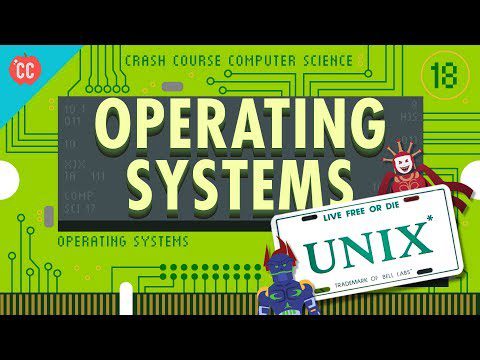Obțineți o reducere de 10% la un domeniu personalizat și o adresă de e-mail accesând https://www.hover.com/CrashCourse.
Deci, după cum probabil ați observat din ultimul episod, computerele continuă să devină din ce în ce mai rapide, iar la începutul anilor 1950 au devenit atât de rapide încât de multe ori a durat mai mult pentru a încărca manual programe prin carduri perforate decât pentru a le rula efectiv! Soluția a fost sistemul de operare (sau OS), care este doar un program cu privilegii speciale care îi permite să ruleze și să gestioneze alte programe. Așadar, astăzi, vom urmări dezvoltarea sistemelor de operare de la Multics și Atlas Supervisor până la Unix și MS-DOS și vom analiza modul în care aceste sisteme au influențat puternic sistemele de operare populare precum Linux, Windows, MacOS și Android pe care le-am utilizați astăzi.
Produs în colaborare cu PBS Digital Studios: http://youtube.com/pbsdigitalstudios
Vrei să afli mai multe despre Carrie Anne?
https://about.me/carrieannephilbin
Cele mai recente de la PBS Digital Studios:
Doriți să găsiți Crash Course în altă parte pe internet?
Facebook – https://www.facebook.com/YouTubeCrash…
Twitter – http://www.twitter.com/TheCrashCourse
Tumblr – http://thecrashcourse.tumblr.com
Curs intensiv de asistență pe Patreon: http://patreon.com/crashcourse
CC Copii: http://www.youtube.com/crashcoursekids
Cursuri interesante:
- Elementele de bază ale alegerilor: Curs intensiv Guvernare și politică #36
- Primele limbaje de programare: curs intensiv Informatică #11
- Cum să puneți un site web online: șablon, codare, domeniu, găzduire și DNS
- Registre și memorie RAM: Crash Course Computer Science #6
- Învățare automată și inteligență artificială: curs intensiv Informatică #34
- onclick() event function in Js javascript course series-L5 #html #css #javascript #frontend#backend
- Relativitate specială: curs intensiv de fizică #42
- Fizica muzicii: curs intensiv de fizică #19
- Instrucțiuni și programe: Curs intensiv Informatică #8
- Magnetism: curs intensiv de fizică #32

great crash course playlist!
Best summary of operating system fundamentals I ever heard! Thanks!
good
What is the difference between os and ios??
Well… So, when are you lot going to GIVE ME MY OPERATING SYSTEM back?!
thank you for present so nice course,love u guys,love u carrie anne !
slow down .. you speaking too fast how we suppose t comprehend. this is not a teaching mode
Great video! I was wondering about all these different types of operating systems that exist and used to, this video was a delight to watch 🙂
love the video! learn more from this than 8 hours studying 🙂 btw where can i get the t-shirt?!
What is atlas supervisor
this channel is simply amazing. i was looking long time for some quick explanation of what filesystem is without goign too much into detail, but all i found is comparisons which are better but not what FS actually is. and then there is this cool channel
The potato/pəˈteɪtoʊ/ is a starchy food, a tuber of the plant Solanum tuberosum and is a root vegetable native to the Americas. The plant is a perennial in the nightshade family Solanaceae.[2]
Wild potato species can be found from the southern United States to southern Chile.[3] The potato was originally believed to have been domesticated (§ History) by Native Americans independently in multiple locations,[4] but later genetic studies traced a single origin, in the area of present-day southern Peru and extreme northwestern Bolivia. Potatoes were domesticated there approximately 7,000–10,000 years ago, from a species in the S. brevicaule complex.[5][6][7] In the Andes region of South America, where the species is indigenous, some close relatives of the potato are cultivated.
Potatoes were introduced to Europe from the Americas by the Spanish in the second half of the 16th century. Today they are a staple food in many parts of the world and an integral part of much of the world's food supply. As of 2014, potatoes were the world's fourth-largest food crop after maize (corn), wheat, and rice.[8] Following millennia of selective breeding, there are now over 5,000 different types of potatoes.[6] Over 99% of potatoes presently cultivated worldwide descend from varieties that originated in the lowlands of south-central Chile.[9] The importance of the potato as a food source and culinary ingredient varies by region and is still changing. It remains an essential crop in Europe, especially Northern and Eastern Europe, where per capita production is still the highest in the world, while the most rapid expansion in production during the 21st century was in southern and eastern Asia, with China and India leading the world production of 376 million tonnes (370,000,000 long tons; 414,000,000 short tons), as of 2021.
Like the tomato, the potato is a nightshade in the genus Solanum, and the vegetative and fruiting parts of the potato contain the toxin solanine which is dangerous for human consumption. Normal potato tubers that have been grown and stored properly produce glycoalkaloids in amounts small enough to be negligible for human health, but, if green sections of the plant (namely sprouts and skins) are exposed to light, the tuber can accumulate a high enough concentration of glycoalkaloids to affect human health.[10]
❤